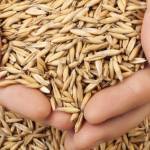Oats for Horses: What’s Old, What’s New

One of the most traditional feed grains for horses is oats. Because oats contain sufficient protein, calcium, and phosphorus to meet the requirements of mature horses, this grain has historically been an important ingredient in feeds for all types of equines. In fact, at one time oats made up almost one-third of all equine feed consumed.
Oats have a number of qualities that make them appealing to horses, owners, and feed manufacturers. They are extremely palatable to horses and are easy to chew, even for older equines whose teeth may not be in perfect condition. They are more easily digested in comparison with heavier whole grains like wheat and corn. Oats are somewhat less susceptible to mold than corn or wheat, and unprocessed oats retain their quality well when properly stored. Shelf life is reduced after oats have been processed.
Starch content of oats ranges from 43 to 61%, averaging around 53%. This starch is readily digested in the small intestine, reducing the risk of digestive upset caused by undigested starch from other feeds that may spill over into the hindgut and impact pH balance. Thus, oats have developed a reputation as a “safe” grain for horses.
The majority of the protein found in oats is in the inner kernel or groat. Protein content ranges from 11 to 24% and is of good quality, but lysine content is lower than in some other feed components. This low lysine content is the reason that oats are not considered a complete feed for young horses who require this amino acid for growth.
About 30 to 35% of the oat’s weight is hull, which is low in energy and nutritive value. However, horses need a certain amount of indigestible fiber to aid in digestive tract mobility. Hulls can sometimes be seen in manure, leading horse owners to worry that the oats are not being utilized by the horse. Closer examination shows that the hulls are empty because the groat has actually been fully digested.
Horse owners sometimes think that it’s a good idea to add an extra scoop of oats to a ration of commercial horse feed. Though horses probably enjoy eating the additional treat, this practice skews the nutrient balance of the commercial feed. A handful of oats won’t hurt the horse from time to time, but owners should not routinely add large quantities of oats to a manufactured feed product.
Oats will get a closer look in a study being funded by a grant from the Equine Feed Oat Project (EFOP). Formed in 2010, EFOP is an initiative of the Prairie Oat Growers Association, a nonprofit organization that represents 15,000 Canadian farmers who grow oats. An important part of EFOP’s mission is to conduct research and promote education about the role of oats in equine nutrition.
The recipient of this grant from EFOP is Laurie Lawrence, Ph.D., a professor at the University of Kentucky. Lawrence, who joined the UK staff in 1992, has more than 30 years of experience in equine nutrition instruction and research. She is the author of numerous technical papers and has been honored by the American Society of Animal Science and the Equine Science Society for her work. As the first recipient of an equine oat research grant from the EFOP, Lawrence will use the award of $122,000 to support a two-year research project. If there are new or unique ways to use oats in horse diets, this research may bring them to light.
The Prairie Oat Growers Association was organized in 1998 and has funded research that has helped produce many new varieties of oats for both the human and equine markets. Matching funds for this most recent project were received from the Saskatchewan Ministry of Agriculture through its Agriculture Development Fund. This fund supports public and private research and development to enhance growth opportunities in the provincial agriculture industry.








